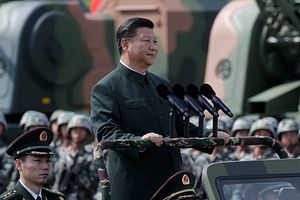March has marked the budget season for the United States and China alike. Earlier this month, at the National People’s Congress, Beijing announced a 7.5 percentage increase in its projected defence spending over last year. It will spend $177.54 billion on sustaining, growing, and modernising its military. The United States, a little more than a year after acknowledging it was in an era of great-power competition again, announced a $750 billion defence budget.
Headlines have zeroed on the relative decrease in spending growth on defence. After all, in 2018, China’s defence budget growth stood at 8.1 per cent. Percentages can be misleading, however. China’s military modernisation objectives remain as ambitious as ever. It continues to plan for multiple contingencies and allocate resources as necessary.
Commensurate with its rapid economic growth and growing global ambitions, China has pursued a large-scale modernisation – and more recently reorganisation – of its military. Under President Xi Jinping, the People’s Liberation Army has diversified away from its historical focus as a land-based force towards the seas.
But the core missions that motivate China haven’t changed – the list has simply gotten longer as the country has risen. A contingency in the Taiwan Strait remains the PLA’s primary war-fighting scenario and nearly every aspect of Chinese military modernisation and expansion is meant to assist in that mission.
Meanwhile, the Chinese Communist Party is ever aware that for it to retain its position atop China’s millions, the PLA must be well managed and, above all, loyal to Xi. Here it is instructive to remember that the PLA is not a professional army like one may find in other countries; it is the armed wing of the party. And atop the party is Xi himself.
Looking at China’s top-line defence spending figures is a limited source of insight into the priorities the country is pursuing. Unlike other countries – certainly the United States – China’s defence spending allocations is notoriously opaque. Beijing’s friends and adversaries alike have little insight into where China’s ever-large defence spending is going.
Of course, from the outside, it’s plainly visible that China has accepted it must prepare for decades of sustained great-power competition with the United States. The PLA Navy continues to add hulls to its growing fleet. Another indigenous aircraft carrier is under construction with additional units planned for future years.
China has also pursued advances in intelligence, surveillance and reconnaissance capabilities – on land, air, sea, and in space – both at the tactical and strategic levels. It is pursuing advanced strategic nuclear-capable weaponry, including hypersonic boost-glide vehicles capable of stressing US theatre missile defence systems. After years, too, the PLA Air Force once again has a nuclear mission.
In coming years, China is likely to devote more attention to developing personnel and, most importantly, generating experience. Unlike the United States, China has not fought a war against a state adversary in decades. Today, even as it accumulates the hardware, Beijing lacks the software to give it confidence.
Slowing defence budgets can thus be misleading. Even if Beijing might not procure hardware at the astonishing rates of recent years – consider that China’s rate of naval hull production between 2014 and 2018 outpaced that of the British, German, Spanish and Indian navies combined – it will accrue greater experience.
Recent years have seen the Chinese air force flying farther, the navy sailing farther, and the rocket force conducting new kinds of exercises. To enable a more expeditionary navy, China’s naval aviators have been accruing flying hours. As China matures as a military great power with an ambitious range of objectives and potential missions, expect the focus to shift from hardware to software.
A version of this article appeared in the South China Morning Post. It is republished here with kind permission.

































